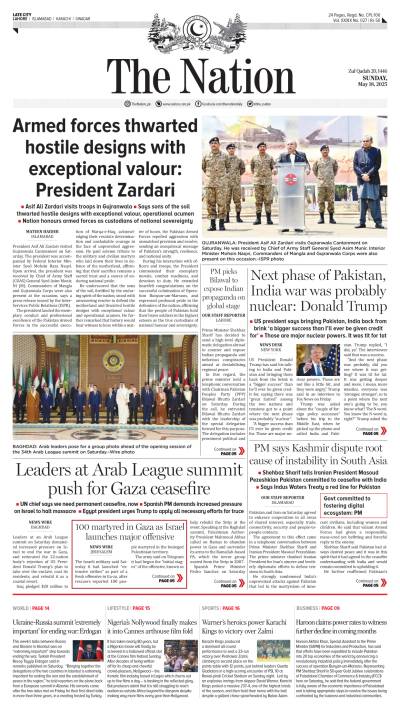ISLAMABAD - Pakistan Muslim League-Nawaz led government, to achieve the destination of prosperity, social development and Roshan Pakistan, has finally drafted a direly needed National Energy Policy 2013-18 which is set to land in today's meeting of the Council of Common Interests for the final approval.
Under the energy policy, power sector subsidy would be phased out till an end to it; end to electricity loadshedding would be made possible till 2017 and surplus electricity till 2018; government-owned power plants and a few power distributing companies (DISCOs) would be privatised; cost of power generation would be brought to a single-digit from two-digit; water and power ministry, National Electric Power Regulatory Authority, Oil and gas Regulatory Authority (OGRA) would be restructured; outstanding dues owed by government-owned and privately-owned bodies would be adjusted through federal adjusters; and regional transmission and power trading system would be established.
A draft copy of the national energy policy available with this scribe reveals the Ministry of Water & Power has prepared this policy to support current and future energy needs of the country.
It is comprised of seven points, with a vision, “Pakistan will build a profitable, bankable and investment-friendly power sector that would meet the needs of its population and boosts its economy in a sustainable and affordable manner while adhering to the most-efficient generation, transmission and distribution standards”.
"The successful implantation of this policy will lead to enormous improvement within the power sector. By 2017, the supply-and-demand gap could be eradicated completely; and by the end of the five-year term of the current government there will be surplus power. The cost of power generation will be reduced to a single-digit per unit, and the efficiency improvements in transmission and distribution will decrease the burden of power on the end-consumer. In summary, prosperity and social development will become a reality in a Roshan Pakistan," the policy reads.
Highlighting the challenges facing the energy sector, the policy states the power sector is currently afflicted by a number of challenges that have led to a crisis. These challenges are a yawning supply-and-demand gap, where the demand for electricity far outstrips the current generation capacity (up to 4500MW to 5000MW); highly expensive generation of electricity (Rs12/unit) is due to an increased dependence on expensive thermal fuel sources (44 per cent of total generation); a terribly-inefficient power transmission and distribution system that currently records losses of 25 to 28 per cent due to the poor infrastructure, mismanagement and theft of electricity.
However, to achieve the long-term vision of the power sector and overcome its challenges, the government has set the following nine goals in its energy policy:
1. Build a power generation capacity that can meet Pakistan's energy needs in a sustainable manner.
2. Create a culture of energy conservation and responsibility.
3. Ensure the generation of inexpensive and affordable electricity for domestic, commercial and industrial use.
4. Minimise pilferage and adulteration in fuel supply.
5. Promote world-class efficiency in power generation.
6. Create a cutting-edge transmission network.
7. Minimise financial losses across the system.
8. Align the ministries involved in the energy sector and improve governance.
Besides, the policy mentions that “a clear strategy has to be articulated for each of the aforementioned goals in order to actualise the power sector's aspirations”. It states the process of policy and strategy formulation is defined through the principles of efficiency, competition, and sustainability. And the efficiency would be predicted on three pillars of merit order, transparency/automation and accountability.
The transparency will be achieved by providing greater and easier access to information through a public website and by optimising transmission through technology/automation. The accountability will be ensured by making hiring on the basis of competence, signing performance contracts with heads of all entities, and exercising zero-tolerance towards corruption and poor performance.
Similarly, competition will be built on three pillars: upfront tariff and competitive bidding, and key client management.
Infrastructure will be developed and incentives provided to attract greater investments in the private sector. The government will set the foundations of energy cities and corridors and sponsor public-private partnership for coal and river based projects.
The government will also redesign and strengthen the national grid transmission network and build a regional transmission and power trading system. It would like to limit its role to policy making and unless necessary, service delivery would be promoted through a competitive and transparent private sector.
The tariff and competitive bidding process will be controlled by a world-class regulatory authority. Upfront tariffs will be set for low cost fuel and competitive bidding will be used to decrease the costs further. Similarly, a transparency and competitive process will be established to privatise government assets.
Under the policy, the government will assign “key client managers or relationship managers" to the Ministry of Water & Power who will act as a one-window operation for investors in the power sector and ensure timely completion of investments and projects.
Again, sustainability will be grounded on three pillars of low cost energy, fair and level-playing field and demand management.
It is also mentioned in detail in the national energy policy that low cost of energy will be ascertained by altering the fuel mix towards less expensive fuels such as hydro, biomass and coal. The power sector will get a privileged access to gas allocation.
Investments required for the low cost fuel (mix) will necessitate rationalisation of power tariff. Similarly, fairness will be ensured by protecting the poor and cross-subsidising their consumption from affluent domestic, commercial and industrial users all across the country. And, demand management will be introduced through time of day metering; setting technology standards (such as green star compliance) for electrical appliances; mandating energy efficient building standards; and subsidizing low cost renewable energy among consumers.
Within the framework of the energy policy principles, the GoP has designed strategies for each of the goals listed in section 4 to actualise its vision and overcome the power crisis.
Supply strategy
Overall, the strategy to achieve the above goal is focused on attracting and directing local and foreign investments towards rapidly expanding the power generation capacity. Investments can only be encouraged if the sector is made attractive and bankable by treating the subsidy to the abject poor and clearing it out through cross-subsidisation mechanisms.
In the short run, the government has already brought the existing capacity online by retiring the circular debt. This action has provided financing to plants that were dormant due to lack of feedstock and or disputes. In the medium term, the power ministry will attract new investments and expedite the pipeline projects on a war-footing basis by employing a key client management system. In the long run, large infrastructure programmes such as the Indus River Cascade will be aggressively developed.
Demand management strategy
To materialise the goal, the policy says that strategy is focused on setting energy conservation and product labelling standards while banning the import of inefficient electronics into the country. The local industry will be granted a three-year exemption period to bring its production to the required levels of power efficiency.
"The strategy may institute curbs for evening commercial activities and introduce time-of-use-metering to discourage utilisation during peak hours by charging different rates for on and off peak timings. Solar and alternative power solution will be encouraged for end-users, streetlighting, electronic billboards, neon lighting, shop front signage, etc. In addition, the price signal articulated through reducing and targeting subsidy will naturally optimise demand and utilization, "the energy policy reads.
Affordable power strategy
The strategy focuses on shifting Pakistan's energy (mix) towards low cost sources such as hydel, gas, coal, nuclear and biomass. Local and foreign investment will be lured for small and medium size hydel projects.
Selected hydel projects under development will be positioned for privatisation. Multilateral agencies will be invited to partner large infrastructure hydel projects. LNG terminals will be developed in close collaboration with friendly countries such as China. Development of coastal energy corridors based on imported coal (mixed later with local coal), rapid proliferation of coal mining all across the country-especially at Thar and conversion of expensive RFO (residual fuel oil) based plants to coal are the central tenets of coal policy. The proposed strategy will change the energy mix of Pakistan in favour of low cost sources and significantly reduce the burden of energy to the end-consumer.
Supply chain strategy
Once relief from loadshedding is achieved through decreasing the supply-and-demand gap, this strategy will focus on redirecting the supply of fuel from inefficient GENCOs to the most efficient IPPs (independent power producers).
This reallocation alone has the potential to save Rs3billion per month and generate additional 500mw electricity. At the same time, the Water & Power Ministry will sign performance contracts with GENCOs, PSO (Pakistan State Oil) and fuel transporters, and hold them accountable for the quality and theft of oil. Fuel procurement contracts may be made open-sourced to eliminate power of a single supplier. Any leakage will be plugged by building fuel pipeline where possible and open decanting. In the event that fuel is found to be missing or adulterated, the fuel economic value of the fuel will be appropriated to the end-receiver.
Generation strategy
This strategy focuses on establishing plant efficiency through external heat rate testing, building a merit order accordingly, and allocating fuel to more meritorious plants. Allocations will be made public online to increase the transparency. The strategy calls for privatisation or O&M-based leasing of GENCOs (power generating companies).
Transmission strategy
This strategy is based on installation of upgrade SCADA software to optimise transmission and monitor its losses. Dispatch will be based on economic order and internal/audit control will be established on dispatch and payment. Plants will be built closer to load centres; high voltage transmission lines will be expanded; and the 220kv rings around cities will be strengthened.
Distribution strategy
In short term, performance contract will be signed with the heads of distribution companies and their respective boards focused on reducing distribution losses due to technical reason, theft, and lack of recovery/ collection. Smart meters will be installed at the feeder level, profit and loss accounts will be managed at the feeder level, and the accountability will be appropriated to the executive engineer. A regime of reward and punishment will be used to improve efficiency and decrease theft.
In the medium term, the efficiency will be improved through privatizing a selected number of distribution companies.
Financial efficiency strategy
This strategy is predicted on collecting outstanding receivables from the provinces and govt departments. Federal adjuster will be appointed to settle disputes. GST (general sales tax) refunds will be collected from the FBR (Federal Board of Revenue) and a mechanism will be built to avoid future build-ups. The financial efficiency strategy is geared towards punishing private defaulters and proposes severing the electric connection of defaulters after 60 days of non-payment and only reconnecting them to the grid with pre-paid meters. External collection agencies may also be sourced to improve cash flows. At the same time, loadshedding may be focused on areas of high theft and low collections as opposed to the current structure of indiscriminate loadshedding.
Governance strategy
This strategy calls for the notification of an Official Coordination Council comprising the Ministry of Water & Power, Ministry of Petroleum, Ministry of Finance and Planning Commission. This council will ensure information integration between all these ministries and will assist in policy formulation and decision making related to energy. The strategy requires the reformation of structural and regulatory aspects of NEPRA (national electric power regulatory authority) and OGRA (oil and gas regulatory authority) to improve efficiencies. New business models including power exchanges and wheeling charges will be explored. Finally, the Ministry of Water & Power will be restructured to strengthen its functional expertise. Directorates will be created for key functions (ie, generation, transmission and distribution) and key organization such as CPPA (central power purchasing agency), and NTDC (national transmission dispatch company) will be reformed.
Sunday, May 18, 2025
Govt drafts energy policy for Roshan Pakistan
-
Lahore emerges among safest global cities in Numbeo 2025 index
-
Lahore emerges among safest global cities in Numbeo 2025 index
-
India’s suspension of Indus Water Treaty legally baseless
-
Seventh polio case reported in Pakistan amid nationwide vaccination drive
-
Pakistan reports sixth polio case of 2025
-
PTA begins issuing VPN licences to regulate usage
Culture Shift
May 18, 2025
Tactical Shift
May 18, 2025
Unmasked Cruelty
May 18, 2025
India Isolated
May 17, 2025
Descent into Hell
May 17, 2025
Fostering Entrepreneurship
May 18, 2025
Behind a Promising Job Offer
May 18, 2025
Indo-Pak Wisdom
May 18, 2025
Traffic Signal at Shahzad Town
May 18, 2025
English a Measure of Intelligence?
May 17, 2025
ePaper - Nawaiwaqt
Nawaiwaqt Group | Copyright © 2025





